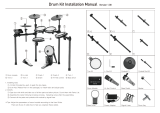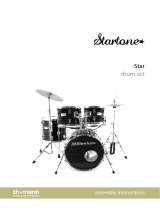
01
MDS-4V Parts of the TD-17KV
For a left-handed setup
03
04
Connection procedure
02
Assembly procedure
05
Setup Guide
© 2018 Roland Corporation
In order to use this device correctly, please carefully read “Using
the Unit Safely” and “Important Notes” (included in each owner’s
manual) before use.
Check the included items
As soon as you open the package, check to see that all items are included. If anything is missing, please contact your dealer.
* This package does not include a kick pedal. Use with a commercially available kick pedal.
* When checking the items
included with the MDS-4V
refer to “MDS-4V Owner’s
Manual.”
The setup described in this guide is for right-handed players. To set up for a left-handed player,
reattach the components as follows.
5 Exchange curved pipes (L) and (R), and straight pipes (L) and (R), left-for-right.
5 Attach holder (C) and the snare pipe to the right side.
5 Attach the mount holder (L) to the curved pipe (L).
5 Exchange the pads and cymbals with their attachment mounts left-for-right.
5 Exchange the TD with its sound module mount left-for-right.
9 When you’ve nished making connections, turn on the power as described in the TD-17/17-L Owner’s Manual, and
verify that you can hear sound.
This completes assembly and connections.
Attach the parts
* Insert the plug rmly,
making sure it’s all the
way in.
1. Connect the cable to TD as shown in the
illustration.
Insert the connector all the way, then turn
the knobs to fasten it securely.
2. Labels indicating the pad to be connected
are attached to the cable. Connect the
cable to the OUTPUT jack of each pad as
shown in the illustration.
Connect the pads to TD
Assemble the stand
Assemble the stand using the procedure described in “MDS-4V Owner’s Manual.”
* The tip of the mount is sharp. Handle it with care.
* When setting up or storing the stand, be careful not to pinch the ngers you use to
handle the stand.
Connect the AC adaptor and
speakers
Connect the AC adaptor, speakers, or headphones as described in the owner’s
manual of the TD.
* To prevent malfunction and equipment failure, always turn down the volume, and turn o all the
units before making any connections.
Connect the cables as shown in the illustration.
CY-8
PDX-12
PDX-8 PDX-8
PDX-8
CY-5
KD-10
FD-9
TD-17/17-L
CY-8
TD-17KV
Adjust the height of the rod so that the highest
point of the cymbal is less than 1.2 meters.
Attach the cymbal so that its center does not
extend toward the back beyond the pipes of
the stand (the pipes at the back of the stand).
Adjusting the position of the cymbal
Attach the snare (PDX-12) and
toms ( PDX-8)
Loosen
Tighten
Rod
Loosen
Tighten
Rod
Attach the hi-hat (CY-5)
Place the hi-hat control pedal (FD-9)
When using on the V-Drums mat,
noise eater, or carpet
When using on the oor
Anchor bolts
If you’re using this unit on a V-Drums mat, on a noise eater
(NE-10), or on carpet, extending the anchor bolts will secure
the unit in place, making it easier for you to perform.
* The tips of the anchor bolts are
sharp. Handle with care.
* When used on ooring, the
anchor bolts may damage the
oor.
1.2 m
OK Not OK
Attach the kick pedal (KD-10)
Install the kick pedal securely.
Tighten the wing nut to
obtain an appropriate
amount of sway.
Attach the crash cymbal (CY-8) and ride cymbal (CY-8)
Wing nut
Felt washer
“Roland” logo on the farther side
Knob
As seen from the back
* Fasten the cables so that they will not
obstruct your playing; use cable clips
and cable ties.
Make sure to wrap the cable ties
around the pipes.
CR1
T2 T1
T3
HH
SNR
RD
TD-17
HHC
KIK
* Do not connect the RDB cable (for
extension). Leave the cap in place,
and fasten the cable so that it will not
hinder your performance.
RDB
1.2 m
* For reasons of safety, do not spread the stand
wider than 1.2 meters (47 inches).
Cymbal mounts
Pad mounts
Pad mounts
Cymbal mount
If the stand wobbles, loosen
this hand knob and adjust
the height.
Loosen this hand knob, and rotate the
mount holder (L) 90 degrees in the direction
of the arrow.
8 Hi-hat control pedal
(FD-9)
8 Cymbal pad for hi-hat
(CY-5)
8 V-Cymbal for crash/ride
(CY-8 x 2)
8 Connection cable
(special for TD)
8 AC adaptor 8 V-Pad for tom (PDX-8 x 3)
8 Setup Guide (this document)
8 Owner’s manual set
8 Drum key
8 Kick pad (KD-10) 8 V-Pad for snare (PDX-12) 8 Drum sound module (TD)
(TD-17 or TD-17-L)
CY-8
PDX-12
PDX-8
PDX-8
KD-10
CY-5
TD-17/17-L
PDX-8
(T1)(T2)
(T3)
(SNR)
(KIK)
(HH)
(CR1)
CY-8
(RD)
FD-9
(HHC)
After exchanging the curved pipes, attach
the holders so that the marks on the pipes
are visible through the gaps of the holders.
Mark
Remove the caps, remove holder (C) and the snare pipe, and
reattach them to the right side.
* Do not connect the RDB cable (for
extension). Leave the cap in place,
and fasten the cable so that it will not
hinder your performance.
CR1
T2T1
T3
SNR
RD
HHC
KIK
HH
TD-17
As seen from the back
RDB
Attach the TD
1. Align the protrusions of the
sound module mount with the
rails of the TD, and slide it in until
you hear it click.
2. Loosen the hand knob of the
mount holder, and insert the
sound module mount.
3. Adjust the angle of the TD, and
then tighten the hand knob.
Attach the stopper so that
the bolt is on the right-hand
side, from the performer’s
perspective.
Tighten the bolt with a drum key.
Stopper
(Be sure to orient it correctly)
Upper clutch
Clutch felt (small)
Clutch felt (large)
Lower clutch
Align with
indentation
While pressing
Use Drum Key to
tighten
Adjust the location at which
the KD-10 is installed so that
it’s at a comfortable position
for playing.
Straight pipe R (short)
Curved pipe R
(including the pad mount)
Straight pipe L (long)
Curved pipe L




